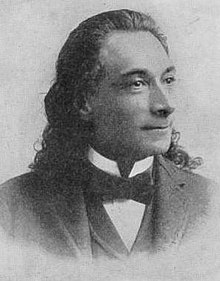Naftali Herz Imber
Naftali Herz Imber | |
|---|---|
 | |
| Born | Naftali Herz Imber 27 December 1856 |
| Died | 8 October 1909 (aged 52) |
| Resting place | Givat Shaul Cemetery, Jerusalem, Israel 31°47′53.28″N 35°10′39.82″E / 31.7981333°N 35.1777278°E |
| Known for | Hatikvah (The Hope) |
Naftali Herz Imber (
Biography
Naftali Herz Imber was born in
In 1882 Imber moved to
In Chicago he met a Protestant physician, Amanda Katie, who converted to Judaism and married him. Israel Zangwill described her as "a Christian crank." The brief marriage ended in divorce.[5] The eminent Jewish judge, Mayer Sulzberger, became his benefactor, providing him with a monthly allowance that allowed him to survive.[2]
Literary career
In 1882, he published his first book of poems, Morning Star (ברקאי Barkai), in
Imber has been described as the "first Hebrew beatnik."
Imber died penniless in New York City on October 8, 1909 from the effects of chronic alcoholism, nonetheless beloved by the local Jewish community.[5] He had made prior arrangement for his burial by selling a poem, but with his immediate family living in Europe and unavailable to make his funeral arrangements, there was controversy about the cemetery in which he was to be buried.[11] He was buried in Mount Zion Cemetery in Queens,[12] In 1953, he was re-interred at Har HaMenuchot, in Jerusalem.
See also
References
- ^ Hatikva, Anthem and Author
- ^ a b c Naphtali Herz Imber, 1856-1909
- ^ Hativkah - Imber, his poem and a national anthem
- Jerusalem Post
- ^ a b Vivian Eden (24 August 2015). "Evil Spirits Lurking in Israel's National Anthem". Haaretz. Retrieved 24 August 2015.
- ^ The Futurist
- ^ Naphtali Herz Imber-Israel Zangwill: A Correspondence
- ISBN 978-0-405-10263-9.
- ^ "The Poet Of Zion Suffers Paralysis - Naphtali Herz Imber, Beloved by His People on the East Side, Dying in a Hospital - Wrote In Classic Hebrew - His "Hatikvah," the Zionist Hymn, Is Sung by Jews All Over the World". New York Times. October 8, 1909. p. 9. Retrieved 24 October 2015.
- ^ See Google Books
- ^ "East Side Poet Is Dead - Strife Over Honor of Burying Author of Zionist National Anthem". New York Times. October 9, 1909. p. 9. Retrieved 24 October 2015.
- ^ "10,000 Follow Bier Of The Zion Poet - With His Zionist Song "Hatikvah" Beside Him, Imber Is Buried from Educational Alliance - Eulogized As A Child - The Poet Never Grew Up from His Boyhood Estate, Says the Rev. J.L. Magnes". New York Times. October 11, 1909. p. 9. Retrieved 24 October 2015.
External links
 Media related to Naftali Herz Imber at Wikimedia Commons
Media related to Naftali Herz Imber at Wikimedia Commons
